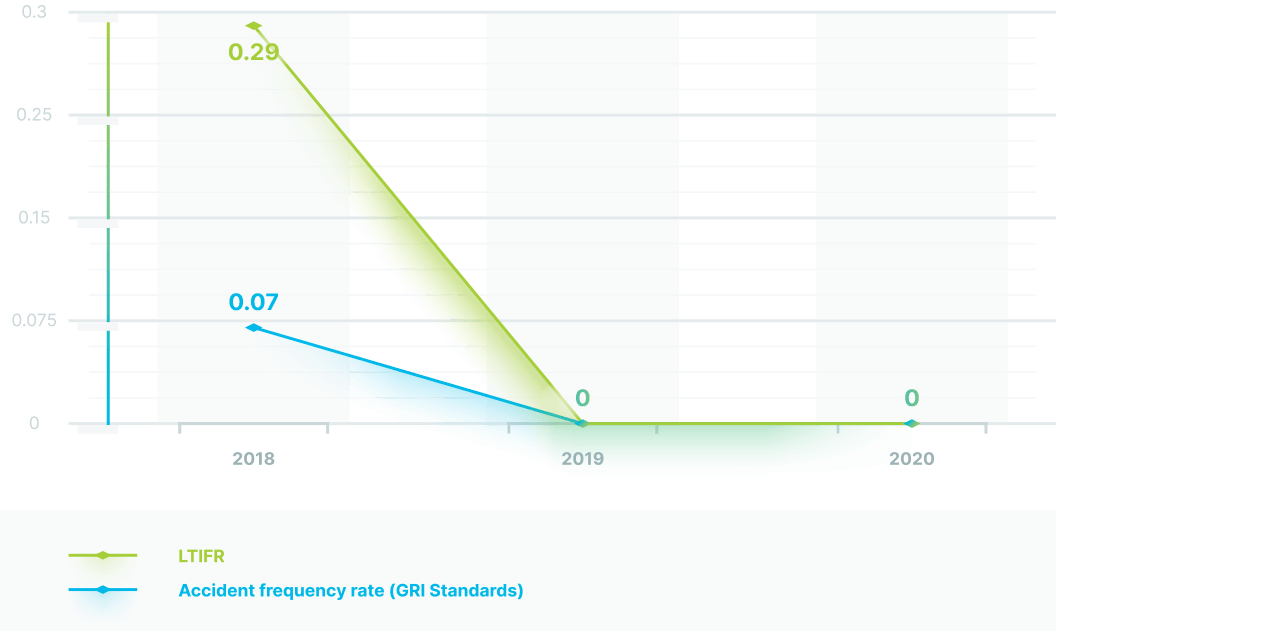Occupational
Safety
The Company has the Occupational Health and Safety Management System, which covers the activities of all the Company’s structural divisions and subsidiaries, which ensures the effectiveness and improvement of occupational health and safety performance and managing the relevant risks related to the specific nature of the Company’s business. The annually formed Occupational Health and Safety Programme defines the necessary activities, costs and deadlines for their implementation.
The Company has successfully implemented and passed certification for compliance with the international standard ISO 45001:2018.
KEGOC and its branches, with the participation of employer and employee representatives on a parity basis, established the occupational health and safety councils to bring the employer and employees together to ensure health and safety at workplaces and appointed technical inspectors participating in inspections of conditions, safety and health at workplaces.
At least once a quarter, the council reviews employees’ proposals for improving health and safety and outlines measures to be taken by the employer and employees.
The risks to which workplaces are exposed are annually identified and assessed. This assessment results in the risk register and the list of significant occupational health and safety risks along with measures to reduce the risks.
The Company employees at least once every three years, undergo all types of compulsory training on occupational health and safety and qualification tests of knowledge of regulatory power industry acts. In 2020, additional training on emergency assistance using defibrillators, training on the new international standard ISO 45001:2018 and training of vehicle drivers on safe driving techniques in extreme conditions were conducted.
Mandatory pre-shift medical examinations of employees engaged in heavy work and work in harmful and/or hazardous conditions, as well as pre- and post-shift medical examinations of drivers are carried out. There is also an annual periodic medical examination of personnel.
The Company’s branches held Health Days where the medical specialists consulted the employees.
No occupational diseases were detected at the Company in 2020.
KEGOC uses the Lost Time Injury Frequency Rate (LTIFR) to assess the safe working conditions. The LTIFR is the world’s main indicator of companies’ occupational safety and health performance. This indicator refers to the number of lost-time injuries (LTI) relative to the total number of hours worked for the Company (Work Hours, WH) for 1 million man-hours. The joint actions on commitment to the occupational safety principles from ordinary employees to top managers of the Company and measures to improve safety conditions made it possible for the Company, over the last two years, to achieve a ‘zero’ level of injury to workers; and the LTIFR for 2020 made ‘0’ (0 in 2019).
No fatalities or work-related accidents were registered in the Company in 2020.
Occupational Safety Indicators

Emergencies and Disasters Response Action Plan
The Company has introduced the business continuity management system that defines business processes/subprocesses requiring the BCM plans. In 2020, work was carried out to identify critical business processes/subprocesses of the Company for which the BCM plans were developed and tested, in particular, to provide technical dispatching services of the system operator, ensure occupational safety and equipment reliability, provide and support information and telecommunication services, manage information security incidents and carry out KEGOC activities in case of emergency.
The BCM plans are represented by Accident Response Plan for operational business processes, the Emergency Action Plan typical for the Executive Administration and its branches for large-scale emergencies and BCM plans for each critical business process for other activity areas.
The Emergency Action Plan reflects actions to be taken at the threat of and on elimination of the consequences of an emergency specifying the periods and duration of works to be done. The most common emergency at the Company’s facilities may be a fire caused by failure to keep up to fire-fighting measures or emergency situations. The Emergency Action Plan also includes actions to be taken at the threat of terrorist acts causing the death of people, significant property damage or other severe consequences. The Company puts into action communication plan, fire warning and extinguishing plan being a part of the Emergency Action Plan for the employees to be timely notified in case of emergency and the emergency to be eliminated.
© 2021 Kazakhstan Electricity
Grid Operating Company
(KEGOC)
If Information Contained
in the Annual Report is Used, the User is Required
to Reference the Actual Report.
All rights reserved.
59 Tauyelsizdik Ave.,
Nur-Sultan, Z00T2D0
Kazakhstan
Tel.: +7 (7172) 69 38 24, 69 02 43
Fax +7 (7172) 21 11 08
E-mail kegoc@kegoc.kz
www.kegoc.kz